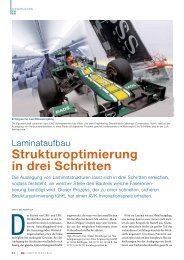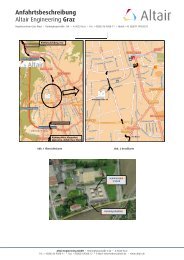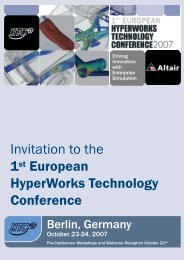HyperWorks 12.0 Release Notes
HyperWorks 12.0 Release Notes
HyperWorks 12.0 Release Notes
You also want an ePaper? Increase the reach of your titles
YUMPU automatically turns print PDFs into web optimized ePapers that Google loves.
esults will be written to the .op2 file, even if the model only contains CTRIA3 elements.<br />
• PS Field on GRID Bulk Data Entry Was Ignored for Geometric Nonlinear Solutions: PS field is now<br />
recognized for the geometric nonlinear solutions, i.e. the NLGEOM, IMPDYN and EXPDYN analysis<br />
types.<br />
• Loads with Magnitude 0.0 Were Incorrectly Interpreted in Geometric Nonlinear Solutions: Forces,<br />
moments, pressures with magnitude 0.0 are now interpreted correctly for the geometric nonlinear<br />
solutions, i.e. the NLGEOM, IMPDYN and EXPDYN analysis types.<br />
• Wrong Thickness Used for Contact Involving Laminated Composite Materials: The correct thickness<br />
is now being used for contacts involving laminated composite materials.<br />
Back to top<br />
RADIOSS for Noise and Vibrations (Bulk Data Format)<br />
AMSES Large Scale Eigenvalue Solver<br />
The AMSES (Automated Multilevel Substructuring Eigenvalue Solver) can calculate thousands of modes<br />
for models with millions of degrees of freedom in less than one hour. The solver scales well with<br />
multiple CPU’s and can be used for modal frequency response and transient analysis, as well as Noise<br />
and Vibration analysis. In addition, it can be used to generate structural and combined fluid-structure<br />
CMS Super Elements. AMSES handles unconnected structures, can be used for modal analysis with<br />
SPCD enforced motion, and runs on both Linux and Windows operating systems. AMSES is an integral<br />
part of RADIOSS and requires no special executable or additional licensing.<br />
Fast Parallel Solver for Modal Frequency Response<br />
A new parallel algorithm has been developed to quickly solve the modal frequency response equations<br />
when thousands of modes are used to define the modal space. With nearly linear parallel speed up<br />
the solver can handle problems with any combination of modal damping, viscous damping, low and<br />
medium rank structural damping in both the fluid and structure. In addition, SPCD enforced motion<br />
can be used and modal energy calculation are available. The use of this new method is controlled by<br />
the PARAM FASTFR.<br />
Modeling the Effect of Heavy Incompressible Fluids on Structural Vibrations<br />
The MFLUID data can be used to model the effects of heavy fluids like oil or gasoline on the structural<br />
vibrations of their containers. This simplified formulation of fluid structure interaction offers an efficient<br />
approach to take fluid effects into consideration.<br />
Equivalent Radiated Power and Far Field Sound Level Pressure<br />
The Equivalent Radiated Power from structural panels can now be calculated. The response can be<br />
calculated for a set of grids or by panels. In addition, the Intensity can be calculated on the panel and<br />
the far field sound pressure level at microphone locations can be output across the frequency range.<br />
One Step Transfer Path Analysis<br />
The Point Mobility, Grid Point Forces, Path Participation, and Transfer functions for multiple control<br />
volumes can all be calculated automatically in a single analysis run. With this new algorithm, the<br />
solution time is significantly less than either of the solution times in the standard two step process.





